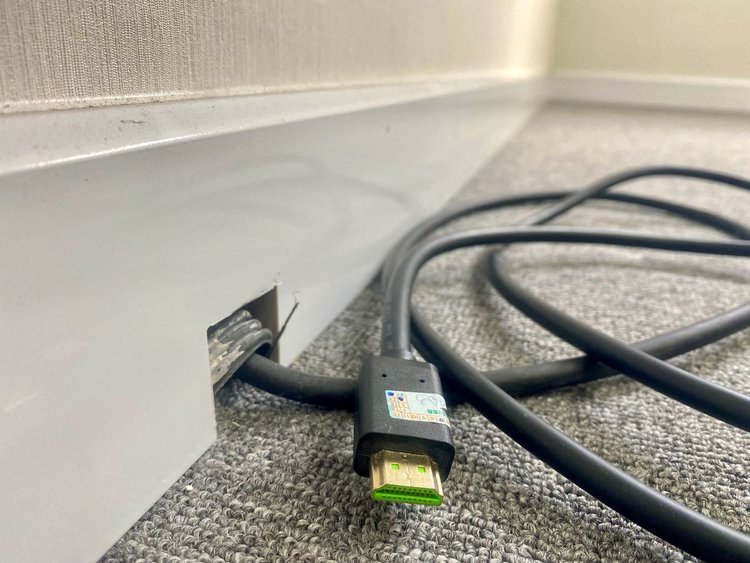In-Wall HDMI Cable Explained: The Safe Route With CL2 & CL3 Ratings!

What To Know
- In-wall rated HDMI cables are designed for safe installation within walls, preventing excessive heat and meeting house building codes.
- CL2 and CL3 ratings indicate fire resistance levels, with CL3 offering higher voltage thresholds and better fire resistance than CL2.
- Using in-wall rated HDMI cables reduces fire risks, especially in residential settings, and they’re becoming more prevalent in the market for added safety.
In this article, we’ll explore the importance of using in-wall rated HDMI cables, a safer option that aligns with most building safety codes.
Let’s dive in!
Quick Navigation
What Is an In-Wall Rated Cable?
In-wall rated cables are cables approved for installation within walls since they do not run as hot during operation. If you or your friends already have a TV or a monitor installed, try touching the HDMI cable the next time they are playing a game or watching a movie at full brightness. You will find that the cable can run quite hot, depending on how long it’s been in use, transferring data.

Most House Building Codes require cables that dissipate heat and need to be run under the drywall to be in-wall rated, and HDMI cables are no exception. In-wall rated cables don’t run as hot even under extensive use. The wire is heavily insulated; therefore, it transfers heat into the output device instead of dissipating it along the length of the wire. An output device like a gaming monitor can vent said heat out quite easily.
You can test it out with a thermometer if you’d like. Get a heavy-duty thermometer or the ones used for cooking and pull out the HDMI wire after a gaming session. Such cables can reach temperatures up to 60°C (140°F) for up to five seconds before getting burnt. Your cable would be around or over the 60-degree range. However, don’t worry, this is quite normal and won’t damage your monitor.
The National Electric Code and NFPA strongly recommend using in-wall rated cables in residential buildings as most walls are made of wood. If you live in a large house or are installing an in-wall cable in commercial or industrial areas with concrete walls, the risk dies down a bit.
The person installing the in-wall rated cable needs to leave the room so you can pull out the cable to perform diagnostics/repair. Besides their main utility, in-wall rated cables improve the aesthetic appeal of any given place since they are out of sight during use, giving a clean look. This benefit has also made in-wall rated cables popular.
When choosing an in-wall HDMI cable, make sure they are at least CL2- or CL3-rated (as per House Building Codes for cables). You can find the relevant code and the cable’s application/purpose on its packaging.
What Is CL2 and CL3 Rating?
CL2 and CL3 ratings are classifications that indicate the level of fire resistance for cable insulations, as stated in Article 725 of the National Electric Code (NEC).
HDMI, DVI, VGA, and Coaxial cables are often linked to CL2 and CL3 ratings.
CL2 Rating
The term “CL2-rated cable” refers to cable categorized as “Class 2 Remote-Control, Signaling, and Power-Limited” cable.
The materials of CL2-rated cable are designed to resist burning when exposed to sudden electricity surges up to 150 volts, and the cable itself does not propagate flames.
The CL2-rated cables are appropriate for in-wall installations and specifically intended for specific low-voltage applications.
Some examples include burglar alarm cabling, intercom wiring, and speaker wire.
CL3 Rating
Similarly, the designation CL3-rated cable refers to a “Class 3 Remote-Control, Signaling, and Power-Limited” cable.
Both CL2 and CL3 ratings share resemblances as they are suitable for in-wall installations and provide flame resistance.
However, the voltage threshold of CL3 ratings is twice that of CL2, at 300 volts.
Common applications for CL3-rated cables include signal wires, intercom wiring, security systems, room and wall speakers, and internet and TV wall installations.
CL2 and CL3 ratings can be further subcategorized as CL2R or CL3R (Riser rating), and CL2P or CL3P (Plenum rating), providing additional specifications.
CL2- vs. CL3-Rated HDMI Cables
| CL2-rated HDMI cable | CL3-rated HDMI cable |
| Voltage threshold up to 150 volts. | Voltage threshold up to 300 volts. |
| Maximum temperature of 60°C (140°F). | Maximum temperature of 70°C (158°F). |
| Both CL2- and CL3-rated HDMI cables can be used in residential and commercial buildings.
Nevertheless, CL3 holds a higher rank in terms of fire resistance compared to CL2. So a CL3-rated cable can be used in place of any CL2-rated cable but not in reversal. |
|
Do You Need In-Wall Rated HDMI Cables?
There are two main considerations to make when determining whether you need an in-wall rated HDMI cable or not.
- The material of the wall you are running your cable through, i.e., concrete or drywall.
- Your local electrical and fire codes.
As mentioned above, most codes require at least a CL2 rating for HDMI cables (‘plenum’ use cables, as per code). These cables are more commonly known as in-wall cables. This term is used commonly, but this usage is incorrect.
As for the material, most US house walls are made of drywall, so you need to ask from where you will be running your wire. You have the option of running it through the ceiling or cutting the wall out. Ceilings can be made out of drywall as well as plaster. For plaster ceilings, the issue may not be as pressing. Using in-wall rated cables is still a good idea for plaster, but the risks aren’t that significant.
Why Do Cables Need to Be In-Wall Rated?
HDMI cables are classified as low-voltage cables, and the risk of fire damage with such is lower. However, the risk is still present. HDMI cables tend to create a lot of smoke because of the fibres around the cable.
Furthermore, if there is no room for the heat to escape, the conduit temperature will eventually rise, causing the wire to melt. In rare cases, it can lead to a small flame, which will most likely spread across the length of the wire, burning the rubber coating outside until it reaches something flammable.
Concrete walls are relatively safer, but the melted wire can still stick to the surface and leave behind smelly, black residue within the wall. In the plenum space, the smoke can also be carried to other parts of the house, affecting more than one room. Burned rubber and HDMI fibres create toxic fumes, which can be harmful to your health.
CL2-rated HDMI cables are very cost-effective and can be found at most local hardware stores, unlike the CL3 wires, which are rarer. If you buy a TV from a local manufacturer (i.e., outside of large brands such as Samsung, LG, Sony, etc.), you might get a CL2 wire automatically with purchase.
Market trends are changing, and the next time you purchase a TV from any brand, you might get in-wall rated cables. In-wall rated cables can save lives by eliminating the risk of fire.
Keep in mind that HDMI cables are relatively fragile. It isn’t uncommon for the connector to be ripped off a regular cable, a CL2 cable, and even a CL3 cable.
3 Best In-Wall Rated HDMI Cables
You can buy in-wall rated HDMI cables from several brands. You will see differences in quality with price. You can expect a more expensive cable to be of better quality than one that is more economical.
1. Monoprice Redmere
- Supports 4k UHD Resolution and 3840 x 2160 @ 24 Hz
- 3D Video Support x.v.Color and Deep Color up to 16-bits per channel 48-bit total
- Audio Return Channel and HDMI Ethernet Channel
Last update on 2024-07-04 / Paid Link.
This cable is considered one of the best CL2 HDMI cables. It is available in different sizes and is suitable for virtually every environment. This simple-looking cable is extremely cost-effective and is ideal for anyone looking to pass their wire through any wall.
2. Amazon Basics
- IN THE BOX: 15-foot high speed HDMI cable
- DEVICE COMPATIBILITY: Connects Blu-ray players, Fire TV, Apple TV, PS4, PS3, XBox one, Xbox 360,...
- 4K VIDEO: Meets HDMI standards 4K video at 60 Hz, 2160p, 48-bit/px color depth, supports bandwidth...
Last update on 2024-07-04 / Paid Link.
The Amazon Basics cable is a great deal, offering a 15ft length at an affordable price without compromising quality. The thicker insulation ensures longevity, making the cable a reliable choice. Additionally, with its CL3 rating and use of low-smoke materials to resist fire, you can confidently use the cable in-wall applications, guaranteeing safety and peace of mind.
3. Zeskit Maya
- Cable length: 4m / 13ft, CL3 rated for in-wall installation
- Ultra High Speed HDMI Cable Certified (w/ Hologram Sticker)
- 48Gbps bandwidth for latest features HDR, HDCP 2.2 & 2.3, DTS:X, Dolby Atmos, Dolby Vision
Last update on 2024-07-04 / Paid Link.
For those who don’t mind spending a few extra bucks on high-quality material, the Zeskit Maya is suitable for all sorts of LED and LCD TVs. The CL3 in-wall rated wire offers exceptional protection against most fire hazards. You have the option of buying a 13ft, 16ft, or 23ft HDMI cable.
Bonuses
1. Do I have to use in-wall certified HDMI cables for drywall?
Yes. If you want to hide cables behind or inside drywall, you should only go for a CL2 or CL3 in-wall-rated cable. The same goes for if you are running the cable in the plenum.
3. How do you know if the HDMI cable is in-wall rated?
If a wire is CL2- or CL3-rated, the cable will likely be in-wall rated. If you aren’t sure or don’t have the packaging, look at the wire closely. You may see a serial number engraved or stamped on it. A simple Google search will help you learn more about it.
Conclusion
Running an HDMI cable from your computer to the monitor may seem like a simple task, but it isn’t necessarily so. Among all the major considerations to make, you also need to get cables that are in-wall rated to ensure there is no fire or smoke hazard in the house.
An HDMI cable, out of all things, may not seem like it could ever lead to a fire, but you’d be surprised how even the smallest things can create much larger costlier issues. In-wall rated cables aren’t as costly as normal wires but can make a huge difference. Make sure you are staying safe and keeping your family and employees safe by making the right decisions.
Hai Huynh, an Electrical & Electronics Engineering graduate from Ho Chi Minh City University of Technology, is a passionate technical editor. He discovered his love for technology when he started playing Pokemon on a Gameboy as a child. Now, he writes and edits technical articles, focusing on smart TVs and streaming devices, to help readers solve problems.





